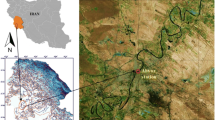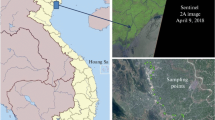Abstract
Remote sensing techniques have been widely used to observe bodies of water. Among satellite sensors commonly used for water quality studies, the Moderate-resolution Imaging Spectroradiometer (MODIS) has potential in water quality monitoring, because of its moderate spatial resolution and high temporal resolution. In this paper, the utility of MODIS data for suspended sediment monitoring in the middle Changjiang (Yangtze) River is studied. It is concluded that suspended sediment concentration correlates well with reflectance values (R 1−R 2)/(R 1+R 2) retrieved from MODIS 250m image data (R 2=0.72, n=41). Based on this correlation, we obtain the empirical model of suspended sediment concentration in the middle Changjiang River from MODIS. It is shown that it is useful for MODIS data to monitor this parameter of water quality.
Similar content being viewed by others
References
CHEN Shen-liang, ZHANG Guo-an, YANG Shi-lun, 2004. Temporal and spatial changes of suspended sediment concentration and resuspension in the Yangtze River estuary and its adjacent waters [J]. Acta Geographica Sinica, 59(2): 260–266. (in Chinese)
DANA L W, RICHARD P S, 1999. Remote estimation of water clarity in optically complex estuarine waters [J]. Remote Sensing of Environment, 68(1): 41–52.
HU Chuan-min, CHEN Zhi-qiang, TONYA D, 2004. Assessment of estuarine water-quality indicators using MODIS medium-resolution bands: initial results from Tampa Bay, FL [J]. Remote Sensing of Environment, 93(3): 423–441.
KOPONEN S, KALLIO K, PULLIAINEN J, 2004. Water quality classification of lakes using 250-m MODIS data [J]. IEEE Geoscience and Remote Sensing Letters, (4): 287–291.
LI Si-hai, YUN Cai-xing, 2001. A study on the quantitative model of the suspended sediment concentration from the meteorological satellite imagery [J]. Journal of Remote Sensing, 5(2): 154–160. (in Chinese)
RUDDICK KG, OVIDIO F, RIJKEBOE M, 2000. Atmospheric correction of SeaWiFS imagery for turbid costal and inland waters [J]. Applied Optics, 39(6): 897–912.
WARRICK J A, MERTES K A, SIEGEL D A, 2004. Estimating suspended sediment concentrations in turbid coastal waters of the Santa Barbara Channel with SeaWiFS [J]. International Journal of Remote Sensing, 25(10): 1995–2002.
ZHAO Chang-hai, YUN Cai-xing, ZHENG Xin-jiang, 1999. Application of meteorological satellite data on the study of silt distribution in the route of the Changjiang River mouth [J]. Remote Sensing for Land & Resources, 39: 15–19. (in Chinese)
Author information
Authors and Affiliations
Additional information
Foundation item: Under the auspices of Post Doctoral Scientific Fund of China (No.2003034495), Knowledge Innovation Program of Chinese Academy of Sciences (No. KZCX1-SW-12-1), and Knowledge Innovation Program of Institute of Geodesy and Geophysics of Chinese Academy of Sciences (No. KSCX2-SW-110)
Biography: LIU Can-de (1980-), male, a native of Tai’an of Shangdong Province, master, specialized in application of RS and GIS. E-mail: candel@asch.whigg.ac.cn
Rights and permissions
About this article
Cite this article
Liu, Cd., He, By., Li, Mt. et al. Quantitative modeling of suspended sediment in middle Changjiang River from modis. Chin. Geograph.Sc. 16, 79–82 (2006). https://doi.org/10.1007/s11769-006-0026-1
Received:
Issue Date:
DOI: https://doi.org/10.1007/s11769-006-0026-1




